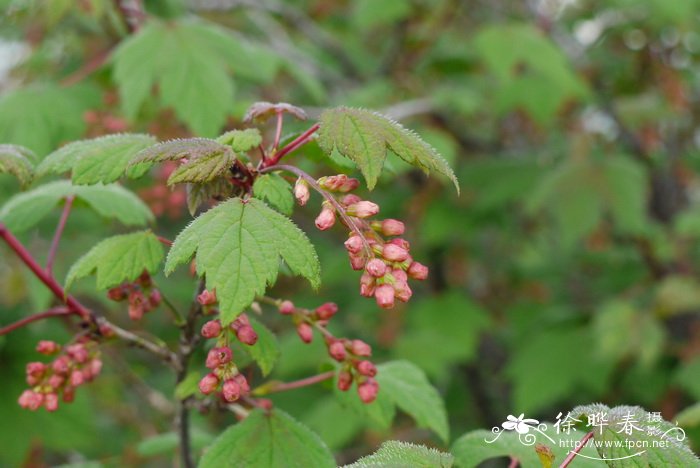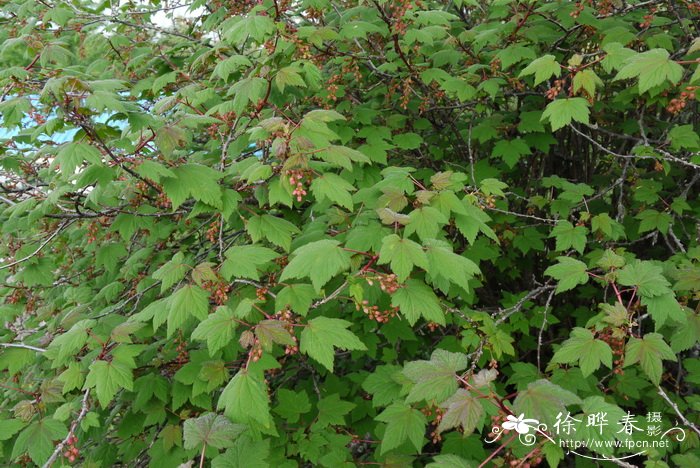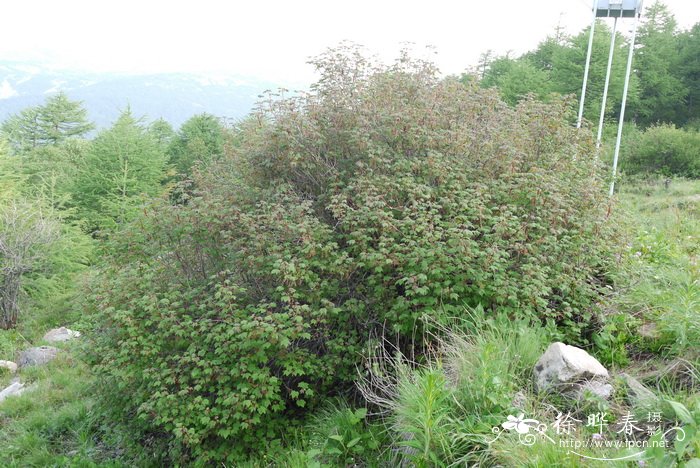糖茶藨子Ribes himalense
中文名(Chinese Name):糖茶藨子
学名(Scientific Name):Ribes himalense Royle ex Decne.
英文名(English Common Name):
别名(Chinese Common Name):糖茶藨子
异名(Synonym):Ribes emodense Rehder Ribes himalayense var. decaisnei Jancz. Ribes himalayense var. urceolatum Jancz. Ribes emodense var. urceolatum (Jancz.) Rohd.
科属(Family & Genus):虎耳草科(Saxifragaceae)茶藨子属
形态特征(Description):落叶小灌木,高1-2米;枝粗壮,小枝黑紫色或暗紫色,皮长条状或长片状剥落,嫩枝紫红色或褐红色,无毛,无刺;芽小,卵圆形或长圆形,长3-5毫米,宽1-2.5毫米,先端急尖,具数枚紫褐色鳞片,外面无毛或仅鳞片边缘具短柔毛。叶卵圆形或近圆形,长5-10厘米,宽6-11厘米,基部心脏形,上面无柔毛,常贴生腺毛,下面无毛,稀微具柔毛,或混生少数腺毛,掌状3-5裂,裂片卵状三角形,先端急尖至短渐尖,顶生裂片比侧生裂片稍长大,边缘具粗锐重锯齿或杂以单锯齿;叶柄长3-5厘米,稀与叶片近等长,红色,无柔毛或有少许短柔毛,近基部有少数褐色长腺毛。花两性,开花时直径4-6毫米;总状花序长5-10厘米,具花8-20余朵,花朵排列较密集;花序轴和花梗具短柔毛,或杂以稀疏短腺毛;花梗长1.5-3毫米;苞片卵圆形,稀长圆形,长1-2毫米,宽0.8-1.5毫米,位于花序下部的苞片近披针形,先端稍钝,微具短柔毛;花萼绿色带紫红色晕或紫红色,外面无毛;萼筒钟形,长1.5-2毫米,宽2.5-3.5毫米;萼片倒卵状匙形或近圆形,长2-3.5毫米,宽2-3毫米,先端圆钝,边缘具睫毛,直立;花瓣近匙形或扇形,长1-1.7毫米,宽1-1.4毫米,先端圆钝或平截,边缘微有睫毛,红色或绿色带浅紫红色;雄蕊几与花瓣等长,着生在与花瓣同一水平上,花丝丝状,花药圆形,白色;子房无毛;花柱约与雄蕊等长,先端2浅裂。果实球形,直径6-7毫米,红色或熟后转变成紫黑色,无毛。花期4-6月,果期7-8月。
分布(Distribution):产湖北、四川、云南、西藏,生于海拔1200-4000米山谷、河边灌丛及针叶林下和林缘。克什米尔地区、尼泊尔、印度和不丹也有分布。
用途(Use):
引自中国植物志英文版:FOC Vol. 8 Page 440
Ribes himalense Royle ex Decaisne in Jacquemont, Voy. Inde. 4(Bot.): 66. 1844.
糖茶藨子 tang cha biao zi| Saxifragaceae | Ribes
Shrubs 1-2 m tall. Branchlets glabrous, unarmed. Buds purplish brown, ovoid to oblong, 3-5 mm, glabrous or puberulent at scale margins, apex acute. Petiole red, 3-5 cm, glabrous or minutely pubescent, sparsely glandular hairy or tuberculate near base; leaf blade ovate to suborbicular, 5-10 × 6-10 cm, sparsely glandular hairy or tuberculate on both surfaces, with or without eglandular hairs, base cordate; lobes 3-5, ovate-triangular, margin roughly sharply doubly serrate, also with some simple teeth, apex acute to shortly acuminate; terminal lobe slightly longer than lateral ones. Racemes dense, (2.5-)5-10 cm, 8-20-flowered; rachis and pedicels pubescent or sparsely stalked glandular; bracts ovate, rarely oblong to sublanceolate, 1-2 mm or slightly longer, puberulent. Flowers bisexual, 4-6 mm in diam.; pedicel 1.5-3 mm. Calyx green tinged purple or purplish red, glabrous or puberulent; tube campanulate, 1.5-2 mm; lobes erect, obovate-spatulate to suborbicular, 2-3.5 mm, margin ciliate. Petals red or green tinged purplish, subspatulate to flabellate, 1-1.7 mm, margin ciliate. Stamens inserted level with petals and subequaling them. Ovary glabrous. Style subequaling stamens, apex 2-lobed. Fruit red, turning purplish black after maturity, globose, 0.6-0.7 cm, glabrous. Fl. Apr-Jun, fr. Jul-Aug.
Mixed, coniferous, or broad-leaved forests and forest margins, thickets on mountain slopes, river banks, or in ravines, grasslands on mountain slopes, mountain valleys, stream banks, roadsides; 1200-4100 m. Gansu, Hebei, NW Henan, W Hubei, Nei Mongol, SE Ningxia, Qinghai, Shaanxi, Shanxi, Sichuan, Xizang, NW Yunnan [Bhutan, Kashmir, Nepal, Sikkim].
Five varieties may be recognized in China. Ribes himalense var. salwinense J. Anthony (Notes Roy. Bot. Gard. Edinburgh 18: 24. 1933), recorded from SE Xizang, NW Yunnan, and N Myanmar, might represent a sixth variety. In the protologue, it was said to differ from var. himalense in having leaf blades hairy on both surfaces; however two of the three cited specimens, Forrest 14957 and Forrest 14985 (both at E), are densely hairy only abaxially, while the third, Forrest 24913 (E), seems no hairier than var. himalense.



(责任编辑:徐晔春)
学名(Scientific Name):Ribes himalense Royle ex Decne.
英文名(English Common Name):
别名(Chinese Common Name):糖茶藨子
异名(Synonym):Ribes emodense Rehder Ribes himalayense var. decaisnei Jancz. Ribes himalayense var. urceolatum Jancz. Ribes emodense var. urceolatum (Jancz.) Rohd.
科属(Family & Genus):虎耳草科(Saxifragaceae)茶藨子属
形态特征(Description):落叶小灌木,高1-2米;枝粗壮,小枝黑紫色或暗紫色,皮长条状或长片状剥落,嫩枝紫红色或褐红色,无毛,无刺;芽小,卵圆形或长圆形,长3-5毫米,宽1-2.5毫米,先端急尖,具数枚紫褐色鳞片,外面无毛或仅鳞片边缘具短柔毛。叶卵圆形或近圆形,长5-10厘米,宽6-11厘米,基部心脏形,上面无柔毛,常贴生腺毛,下面无毛,稀微具柔毛,或混生少数腺毛,掌状3-5裂,裂片卵状三角形,先端急尖至短渐尖,顶生裂片比侧生裂片稍长大,边缘具粗锐重锯齿或杂以单锯齿;叶柄长3-5厘米,稀与叶片近等长,红色,无柔毛或有少许短柔毛,近基部有少数褐色长腺毛。花两性,开花时直径4-6毫米;总状花序长5-10厘米,具花8-20余朵,花朵排列较密集;花序轴和花梗具短柔毛,或杂以稀疏短腺毛;花梗长1.5-3毫米;苞片卵圆形,稀长圆形,长1-2毫米,宽0.8-1.5毫米,位于花序下部的苞片近披针形,先端稍钝,微具短柔毛;花萼绿色带紫红色晕或紫红色,外面无毛;萼筒钟形,长1.5-2毫米,宽2.5-3.5毫米;萼片倒卵状匙形或近圆形,长2-3.5毫米,宽2-3毫米,先端圆钝,边缘具睫毛,直立;花瓣近匙形或扇形,长1-1.7毫米,宽1-1.4毫米,先端圆钝或平截,边缘微有睫毛,红色或绿色带浅紫红色;雄蕊几与花瓣等长,着生在与花瓣同一水平上,花丝丝状,花药圆形,白色;子房无毛;花柱约与雄蕊等长,先端2浅裂。果实球形,直径6-7毫米,红色或熟后转变成紫黑色,无毛。花期4-6月,果期7-8月。
分布(Distribution):产湖北、四川、云南、西藏,生于海拔1200-4000米山谷、河边灌丛及针叶林下和林缘。克什米尔地区、尼泊尔、印度和不丹也有分布。
用途(Use):
引自中国植物志英文版:FOC Vol. 8 Page 440
Ribes himalense Royle ex Decaisne in Jacquemont, Voy. Inde. 4(Bot.): 66. 1844.
糖茶藨子 tang cha biao zi| Saxifragaceae | Ribes
Shrubs 1-2 m tall. Branchlets glabrous, unarmed. Buds purplish brown, ovoid to oblong, 3-5 mm, glabrous or puberulent at scale margins, apex acute. Petiole red, 3-5 cm, glabrous or minutely pubescent, sparsely glandular hairy or tuberculate near base; leaf blade ovate to suborbicular, 5-10 × 6-10 cm, sparsely glandular hairy or tuberculate on both surfaces, with or without eglandular hairs, base cordate; lobes 3-5, ovate-triangular, margin roughly sharply doubly serrate, also with some simple teeth, apex acute to shortly acuminate; terminal lobe slightly longer than lateral ones. Racemes dense, (2.5-)5-10 cm, 8-20-flowered; rachis and pedicels pubescent or sparsely stalked glandular; bracts ovate, rarely oblong to sublanceolate, 1-2 mm or slightly longer, puberulent. Flowers bisexual, 4-6 mm in diam.; pedicel 1.5-3 mm. Calyx green tinged purple or purplish red, glabrous or puberulent; tube campanulate, 1.5-2 mm; lobes erect, obovate-spatulate to suborbicular, 2-3.5 mm, margin ciliate. Petals red or green tinged purplish, subspatulate to flabellate, 1-1.7 mm, margin ciliate. Stamens inserted level with petals and subequaling them. Ovary glabrous. Style subequaling stamens, apex 2-lobed. Fruit red, turning purplish black after maturity, globose, 0.6-0.7 cm, glabrous. Fl. Apr-Jun, fr. Jul-Aug.
Mixed, coniferous, or broad-leaved forests and forest margins, thickets on mountain slopes, river banks, or in ravines, grasslands on mountain slopes, mountain valleys, stream banks, roadsides; 1200-4100 m. Gansu, Hebei, NW Henan, W Hubei, Nei Mongol, SE Ningxia, Qinghai, Shaanxi, Shanxi, Sichuan, Xizang, NW Yunnan [Bhutan, Kashmir, Nepal, Sikkim].
Five varieties may be recognized in China. Ribes himalense var. salwinense J. Anthony (Notes Roy. Bot. Gard. Edinburgh 18: 24. 1933), recorded from SE Xizang, NW Yunnan, and N Myanmar, might represent a sixth variety. In the protologue, it was said to differ from var. himalense in having leaf blades hairy on both surfaces; however two of the three cited specimens, Forrest 14957 and Forrest 14985 (both at E), are densely hairy only abaxially, while the third, Forrest 24913 (E), seems no hairier than var. himalense.
(责任编辑:徐晔春)
踩一下[0]

顶一下[0]